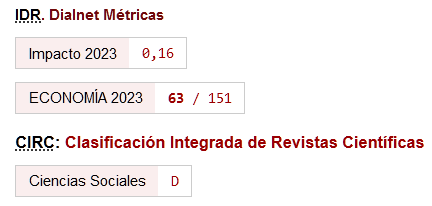Problems of overaccumulation in China
Keywords:
investment, overproduction, productivity, rateof profit, ChinaAbstract
The Chinese investment rate reaches a world record in 2009, exceeding 45% of the GDP. However, this very strong accumulation process may be extremely dangerous for the continuation of the national investment. Most of the time, the emphasis is put on the importance of overproduction and idle capacities: Chinese industry often works at only 50% of its production capacities, what threatens the productivity growth. Nevertheless, this evolution of productivity has to be considered overall by the yardstick of the theory of the falling rate of profit, introduced by Karl Marx in the third book of Das Kapital.
Downloads
References
Aglietta, Michel y Landry, Yves (2007): La Chine vers la superpuissance, Paris, Economica, 176 págs.
Anderson, Jonathan (2007): "China should speed up the yuan's rise", in Far Eastern Economic Review, verano.
Artus, Patrick (2008): La Chine, Le Cercle des Economistes, Paris, Presses Universitaires de France, 93 págs.
Barnett, Steven y Brooks, Ray (2006): "What's driving investment in China", IMF Working Paper n° 265, noviembre, 39 págs.
https://doi.org/10.5089/9781451865257.001
Boutillier, Sophie y Uzinidis, Dimitri (1989): Chine, Questions sur l'ouverture aux multinationales, Paris, L'Harmattan, 157 págs.
Chang, Gordon (2001): The coming collapse of China, Nueva York, Random House, 344 págs.
Cieniewski S., Benaroya F. (2004): "Chine : la longue marche vers la société de prospérité moyenne", DREE dossiers, octubre, www.dree.org
Cieniewski, Stéphane (2005): "Les entreprises chinoises. Forces et faiblesses. Défis et perspectives", Article DREE, 14 diciembre, 7 págs., www.dree.org
Cieniewski, Stéphane (2006): "La profitabilité des entreprises chinoises", Fiches de Synthèse DREE, 28 abril, 7 págs., www.dree.org
Delozier, Benjamin y Hochraich, Diana (2006): "L'investissement en Chine est-il excessif?", in Economie et Prévisions, n° 173, febrero.
https://doi.org/10.3406/ecop.2006.7945
Eyraud, Corinne (1999): L'entreprise d'Etat chinoise, De l'institution sociale totale vers l'entité économique, Paris, L'Harmattan, 397 págs.
Felipe, Jesus y Xiaoqin Fan, Emma (2005): "The diverging patterns of profitability, investment and growth of China and India, 1980-2003", CAMA Working Paper Series 22/2005, The Australian National University, noviembre, 38 págs.
Gaulard, Mylène (2009): Accumulation du capital et inégalités : une approche comparée Chine/Brésil, Thèse de doctorat, Panthéon-Sorbonne, Paris, 570 págs.
Hay, Françoise y Yunnan, Shi (2006): La Chine : forces et faiblesses d'une économie en expansion, Renes, Presses Universitaires de Rennes, 411 págs.
He, Qinglian (1999): "China's latent economic crisis and potential risks", in Modern China Studies, vol. 65, n° 2.
Henry, Gérard-Marie (2006): Quand la Chine s'essoufflera : atterrissage en douceur ou crash, Studyrama, Levallois-Perret, 223 págs.
Hofman, Bert y Kujis, Louis (2006): "Profits drive China's boom", Far Eastern Economic Review, octubre, págs. 39-43.
Krugman, Paul (2000): Pourquoi les crises reviennent toujours, Paris, Seuil, 213 págs.
Kujis, Louis y Tao, Wang (2005): "China's pattern of growth: moving to sustainability and reducing inequality", China and the World Economy, vol. 14, n° 1, enero-febrero. https://doi.org/10.1111/j.1749-124X.2006.00003.x
Lardy, Nicholas (2006): "China : toward a consumption-driven growth path", Washington, Institute for International Economics, octubre. https://doi.org/10.2139/ssrn.2126152
Lin, Justin (2000): Le miracle chinois, stratégie de développement et réforme économique, Paris, Economica, 250 págs.
Lin, Justin, Fang Cai, Zhou Li (2007): "The Lessons of China's transition to a market economy", in The CATO Journal, vol. 16, n° 2.
Lindbeck, Assar (2006): "An Essay on Economic reforms and social change in China", World Bank Policy Research Working Paper, n° 4057, noviembre. https://doi.org/10.1596/1813-9450-4057
Maddison A. (1998): L'économie chinoise, une perspective historique, OCDE, Paris, 212 págs. https://doi.org/10.1787/9789264263550-fr
Marx, Karl (1972): Le Capital, Livre III, La Pléiade, Gallimard, Paris. [México, Fondo de Cultura Económica, vol. III, 1973].
Minqi Li (2003): "Aggregate demand, productivity, and disguised unemployment in the Chinese Industrial Sector", World Development, Vol. 32, n° 3, octubre, págs. 409-425. https://doi.org/10.1016/j.worlddev.2003.10.002
Nhu Nguyen Ngo (2006): "Chine: bilan social contrasté d'un formidable essor", BNP Paribas, Conjoncture, julio.
Palley, Thomas (2006): "External contradictions of the Chinese Development Model: export-led growth and the dangers of global economic contraction", Journal of Contemporary China, vol. 15, n° 46, febrero, págs. 69-88. https://doi.org/10.1080/10670560500331732
Perotti, Enrico y Sun, Laixiang (1998): "State-owned versus township and village enterprises in China", The United Nations University, World Institute for Development Economics Research, Working Paper n°150, septiembre, http://www.eldis.org/static/DOC7017.htm, 35 págs.
Plantade, Jean-Marc et Yidir (2006): La Face cachée de la Chine, Paris, Bourin Editeur, 284 págs.
Weijian, Shan (2006): "The World Bank's China delusions", in Far Eastern Economic Review, septiembre, págs. 29-32.
Weijian, Shan (2006): "China's low-profit growth model", in Far Eastern Economic Review, noviembre, págs. 23-28.
World Bank (1997): China 2020, Washington, World Bank, 161 págs.
Wu, Yanrui (1996): Productive performance in Chinese enterprises, Londres, Macmillan Press, 188 págs. https://doi.org/10.1057/9780230372535
Downloads
Published
How to Cite
Issue
Section
License
This licence allows third parties to share (copy and redistribute the material in any medium or format) and adapt (remix, transform and create from the material for any purpose, including commercial purposes), provided that authorship and first publication in this journal (The Journal, DOI of the work) is acknowledged, a link to the licence is provided, and it is stated whether changes have been made to the work.







